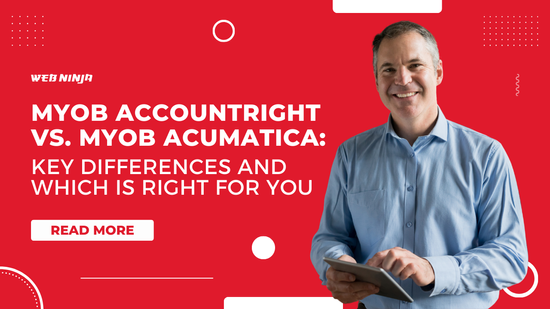MYOB AccountRight vs. Acumatica: Key Differences Explained
Updated on June 13, 2025 | By Jeffrey Almarez | 8-minute read
Looking Beyond Features: What Really Matters in Your Accounting Software
If you’ve ever found yourself knee-deep in spreadsheets, juggling inventory data and payroll, you know that finding the right accounting system isn’t just about ticking boxes. It’s about choosing a tool that keeps pace with your business—whether you're streamlining day-to-day operations or preparing for the next phase of growth.
MYOB remains a staple in Australia’s business software landscape. But within its product suite, MYOB AccountRight and MYOB Acumatica (formerly MYOB Advanced) serve distinctly different purposes. The challenge? Knowing which one aligns with your current operations, team size, and future direction.
Let’s unpack both options, with clarity and context, so you can make a decision that feels as solid six months from now as it does today.
MYOB AccountRight: A Familiar Workhorse for Growing Businesses
MYOB AccountRight is a well-established accounting solution designed primarily for small to medium-sized enterprises (SMEs). It covers a broad range of core functions, including:
- Invoicing and billing
- Payroll (compliant with ATO requirements)
- GST and BAS preparation
- Inventory tracking
- Bank reconciliation with automated feeds
- Financial reporting tools
- Online and offline access with cloud synchronisation
For many business owners, especially those who have grown from sole trader status, AccountRight feels intuitive. Its interface mirrors what you'd expect from desktop accounting software, yet it offers online access—a handy bridge between traditional setups and more modern, cloud-first solutions.
Who it suits: Businesses with up to 20-30 employees, relatively straightforward accounting needs, and limited IT resources. It’s perfect if you're managing finances in-house or with the help of an external bookkeeper.
MYOB Acumatica: Built for Complexity, Growth, and Customisation
On the other hand, MYOB Acumatica is not just accounting software. It’s a cloud-based ERP (Enterprise Resource Planning) platform designed for larger businesses or those with more complex workflows, multi-entity structures, or industry-specific needs.
Acumatica isn’t confined to finance—it integrates functions across:
- Advanced financials (multi-entity, multi-currency, deferred revenue)
- Project accounting
- Customer Relationship Management (CRM)
- Inventory and warehouse management
- Field service management
- Construction, manufacturing, and distribution modules
Built on a flexible and open architecture, Acumatica allows businesses to customise workflows, integrate third-party apps, and automate multi-layered processes—all within a single platform.
Who it suits: Mid to large-sized businesses, especially those in manufacturing, distribution, or professional services, and any organisation managing multiple branches, currencies, or departments.
Key Differences: A Side-by-Side Comparison
Feature |
MYOB AccountRight |
MYOB Acumatica |
|
Deployment |
Desktop with cloud sync |
Fully cloud-based ERP |
|
Ideal Business Size |
Small to medium |
Medium to large |
|
Accounting Features |
Core accounting, payroll, inventory |
Advanced financials, multi-company, project accounting |
|
Customisation |
Limited |
Extensive |
|
CRM & Project Tools |
Minimal |
Integrated CRM and project modules |
|
Scalability |
Moderate |
High – grows with business complexity |
|
Third-Party Integrations |
Yes, limited |
Extensive API and ERP connectors |
|
Support and Training |
Standard MYOB support |
Dedicated onboarding, training, and partner ecosystem |
A Real-World Scenario: Jane’s Logistics vs. Apex Manufacturing
To illustrate this further, let’s consider two fictional businesses:
Jane’s Logistics is a growing third-party logistics company with 15 staff. They handle domestic freight and need simple invoicing, payroll, and inventory management. They use Xero for accounting now but need more functionality—something robust yet familiar. MYOB AccountRight gives Jane everything she needs without overwhelming her team.
Apex Manufacturing, however, operates across three Australian states, with plans to expand into Southeast Asia. They require real-time stock tracking, integrated CRM for their sales team, and detailed project costing. MYOB Acumatica offers the custom modules and multi-entity support they need to scale without needing to switch platforms later.
Pricing and Value: Understanding the Investment
MYOB AccountRight
- Plans: Tiered pricing starting with the “Lite” plan ($30/month AUD) up to Premier plans ($140/month AUD).
- What’s Included: Core accounting features, payroll, inventory, and cloud access.
- Ideal Use Case: Cost-effective for small to medium-sized enterprises (SMEs). You’re getting proven software without unnecessary bells and whistles.
MYOB Acumatica
- Plans: Subscription-based, pricing varies based on user roles, modules, and usage volumes.
- Implementation: Usually involves a certified MYOB partner for setup, customisation, and training.
- Value Proposition: Higher upfront costs, but pays off through efficiency, scalability, and custom fit.
For context, Acumatica uses a “resource-based pricing” model, which means you pay for system usage rather than per-user licences. This is particularly useful for growing teams, as you can onboard more staff without constantly upgrading plans.
Integration Capabilities: Plug and Play or Built to Connect?
MYOB AccountRight:
- Integrates with apps like Shopify, WooCommerce, Square, and others.
- Syncs with payment gateways, eCommerce platforms, and CRM systems via connectors (like those offered by Web Ninja).
- Limited flexibility in highly customised workflows.
MYOB Acumatica:
- Built with open APIs—meaning it integrates deeply with other enterprise tools.
- Supports industry-specific add-ons, including warehouse systems, service dispatch tools, and external CRMs.
- Enables data centralisation across departments—ideal for businesses managing multiple touchpoints.
According to a Forbes Technology Council, ERP systems like Acumatica significantly reduce operational friction by breaking down information silos—something traditional accounting software struggles with.
Support, Training, and Community
MYOB AccountRight:
- Self-guided support resources
- Community forums
- MYOB phone/email support
- Accessible for non-technical users
MYOB Acumatica:
- Partner-led implementations
- Role-based training
- Custom user manuals
- Dedicated customer success managers
For businesses implementing Acumatica, the onboarding process is typically led by MYOB-certified consultants. This ensures that custom modules, reporting dashboards, and user workflows are aligned with your business goals from day one.
Regulatory Compliance: Staying in Step with Australian Standards
Both platforms are ATO-compliant and offer Single Touch Payroll (STP) capabilities. However, Acumatica goes a step further by supporting:
- Audit trails for governance
- Multi-entity tax reporting
- Real-time financial consolidation across business units
This added compliance layer is particularly beneficial for businesses in regulated industries, such as healthcare or finance.
You can verify Australian tax compliance standards for software providers on the Australian Business Software Industry Association (ABSIA) website.
How to Decide: 5 Simple Questions to Ask Yourself
Still undecided? Consider these questions:
- How complex are my operations?
- If you're tracking projects, handling foreign currency, or managing inventory across warehouses, Acumatica is worth exploring.
- How many users need access?
- AccountRight works well for smaller teams. Acumatica scales better for growing departments.
- What’s my budget—now and in 12 months?
- AccountRight is affordable short term. Acumatica is a strategic investment with long-term ROI.
- Do I need a CRM or project tool built-in?
- Acumatica includes both. AccountRight requires add-ons.
- Will I need to customise workflows or reports?
- Acumatica gives you full control. AccountRight keeps it simple.
Web Ninja’s Role in Seamless Integration
No matter which MYOB product you choose, integrating it into your wider business operations is key.
At Web Ninja, we specialise in custom integrations for both MYOB AccountRight and MYOB Acumatica. From eCommerce platforms like Shopify and WooCommerce to freight software like Starshipit, we help connect your systems so they work as one.
Our services include:
- Custom API integrations
- Data migration and setup
- Ongoing support and system audits
- Compatibility with major accounting, CRM, ERP, and warehouse tools
Visit our MYOB integration services to see how we can help your business work smarter—not harder.
Final Thoughts: Matching Software to Strategy
Choosing between MYOB AccountRight and Acumatica isn’t a matter of “which is better”—it’s about which fits where you are, and where you’re headed.
- If you’re a growing SME, with no plans for complex project management or multiple branches, AccountRight delivers more than enough—at a manageable price.
- If you’re expanding, managing multiple business units, or in a sector that demands deep reporting and automation, Acumatica provides the infrastructure to support that growth.
As with any core system, take time to plan the transition, talk to your team, and work with an implementation partner who understands your sector.
Ready to connect your accounting software to the rest of your business tools?
Let Web Ninja help you streamline your systems with precision-fit integration services. Contact us today to find the best solution for your business goals.





